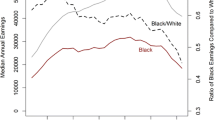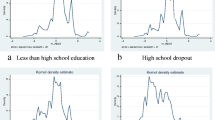Abstract
In comparing the earnings of African American women to three reference groups—white women, African American men, and white men—three principal findings emerge. First, African American women residing in the suburbs are worse off than any other suburban group. Second, central city African American women are worse off than any other group of central city residents. Third, while central city residence imposes a statistically significant earnings penalty on men of both races, no such penalty is found for African American or white women. Therefore, African American women will enjoy no earnings advantage if they move to the suburbs. This finding underscores the importance of including women in studies of residential location and the socioeconomic status of African Americans. A narrow focus on male data to inform policy is clearly insufficient.
Similar content being viewed by others
Notes
See John F. Kain, “Housing segregation, Negro employment, and metropolitan decentralization,”Quarterly Journal of Economics, 82, 2 (1968), 175–97; also see Duran Jr. Bell, “Residential location, economic performance, and public employment,” inPatterns of Racial Discrimination, ed. G.M. Von Furstenburg, A.R. Horowitz, and B. Harrison (Lexington, Mass.: Lexington Books, 1974); Sheldon Danziger and Michael Weinstein, “Employment location and wage rates of poverty-area residents,”Journal of Urban Economics, 3 (1976), 127–45; Emily Hoffnar, and Michael Greene, “Residential location and the earnings of white and Hispanic men,”Applied Economics Letters, 1 (1994a), 127–31; Emily Hoffnar and Michael Greene (1994b), “The impact of central city residence on the earnings of white and African American males: a bivariate selectivity approach,” unpublished manuscript. Richard Price and Edwin Mills, “Race and residence in earnings determination,”Journal of Urban Economics, 18 (1985), 1–18. Clifford E. Reid, “The effect of residential location on the wages of black women and white women,”Journal of Urban Economics, 18 (1985), 350–63; Edwin A. Sexton, “Residential location, workplace location, and black earnings,”Review of Regional Studies, 17, 1 (1991), 11–20.
See Danziger and Weinstein (1976).
See Price and Mills (1985); Reid (1985); Sexton (1991); and Hoffnar and Greene (1994b).
See Price and Mills (1985); Sexton (1991); and Hoffnar and Greene (1994b).
See Bell (1974).
See Reid (1985).
See James Heckman, (1979) “Sample selection bias as a specification error,”Econometrica, 47, 153–61. Labor force participation probit results, while not presented here, are available from the authors.
See Price and Mills, “Race and residence in earnings determination,”Journal of Urban Economics, 19 (1985), 1–18; Edward Sexton, “Residential location, workplace location, and black earnings,”Review of Regional Studies, 17, 1(1991), 11–20; Vroman and Greenfield, “Are blacks making it in the suburbs? Some evidence on intrametropolitan spatial segmentation,”Journal of Urban Economics, 7, (1980), 155–67; and Hoffnar and Greene (1994b).
U.S. Department of Commerce, Bureau of the Census.Current Population Survey: Annual Demographic File 1990 [Computer file]. 2nd release. Washington, DC: U.S. Department of Commerce, Bureau of the Census [producer], 1991. Ann Arbor, MI: Inter-university Consortium for Political and Social Research [distributor], 1991.
See Hoffnar and Greene (1994a).
About this article
Cite this article
Hoffnar, E., Greene, M. Residential location and the earnings of African American women. The Review of Black Political Economy 23, 103–111 (1995). https://doi.org/10.1007/BF02689994
Issue Date:
DOI: https://doi.org/10.1007/BF02689994




